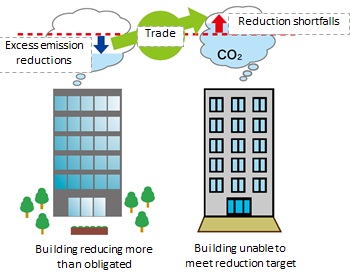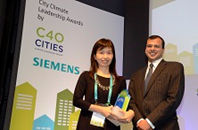|
System Maintenance Announcement:This website is scheduled for system maintenance on Saturday, March 18 (JST).Use of the e-mail forms will be interrupted between 11:30 and 12:30.We apologize for any inconvenience. Thank you for your understanding. |

Please enable JavaScript to use the website of the Tokyo Metropolitan Government.
Main content starts here.
Tokyo Cap-and-Trade Program
Climate change from global warming is a serious environmental issue throughout the world. In order to mitigate the risks of climate change, in fiscal 2010, the Tokyo Metropolitan Government (TMG), as an initiative to quickly and significantly reduce carbon dioxide emissions, launched the Tokyo Cap-and-Trade Program, which makes it mandatory for large-scale facilities in Tokyo to reduce their CO2 emissions.
A feature of Tokyo is that the amount of energy consumed by office buildings and other commercial facilities account for a large 40 percent of total energy consumption. Because reduction of energy use in this sector is extremely important, an urban cap-and-trade scheme was introduced to cover the commercial sector in addition to the factories and other facilities of the industrial sector. This program is not only the first cap-and-trade scheme in Japan, but also the world’s first urban cap-and-trade scheme.
Other than reducing emissions through their own efforts, facilities falling under this program can achieve their reduction targets by procuring the excess emission reductions of other facilities through emissions trading. This system allows businesses to advance initiatives in an economic and rational way.
Overview
(Tokyo Metropolitan Environmental Security Ordinance amended June 2008, enforced April 2010)
|
Covered facilities |
|
|---|---|
|
Compliance period |
|
|
Base-year emissions |
|
|
Compliance factor |
|
|
Organization for promotion |
|
|
Non-compliance measures |
|
[Image of emissions trading]

Highly evaluated overseas
Awards received from international organizations, and other notable achievements

City Climate Leadership Awards ceremony
- 2011 COP 17 Government Leadership Award
- High appraisal of the world’s first urban cap-and-trade scheme
- 2013 C40 & Siemens City Climate Leadership Award
- High appraisal of CO2 emissions reduction by 23% in the second year of the cap-and-trade program.
- 2014 UN Framework Convention on Climate Change Technical Expert Meeting
- Presented TMG’s experience at the UNFCCC
- 2015 ICLEI Transformative Action Programs (TAP) for low-carbon and climate resilient development
- Tokyo cap-and-trade program was selected as one of the transformative action programs promoted by about 120 sub-national governments of the world